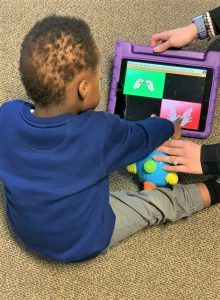Speech and Language Development for Your Child with Autism
Speech therapy addresses language and communication skills.
Social Communication
- Ability to initiate or participate in play with another person
- Awareness of others’ emotional states, perspective and intentions
- Ability to seek attention from others
- Respecting personal space between people
- Playing with toys appropriately
- Pretend play concepts
- Turn-taking play
- Conversational skills
- Initiating conversation with others
- Participating in return conversation with follow up questions
- Maintaining a similar topic in conversation
- For example, not only talking on topics he/she is interested in
Language Development
Increasing number of newly learned words
Interesting Facts: Expressive Language
Sign language encourages expressive language development
Tip: Name everything in their world to increase the number of words they know
- Name everything in their world to increase the number of words they understand
- Use a variety of words. For example, do not call all footwear shoes but name them specifically like slipper, boot, flip flop and sandal.
- Use descriptive words. Example: big green leaf or fast white car
Using words in the correct order/correct tenses (i.e, “him go to the store”)
Maintaining number of learned words such that you do not lose words that were previously acquired
Receptive and expressive language skills maintained and improved
-The ability to understand what is said (receptive language)
-The ability to express thoughts through words (expressive language)
Interesting Facts: Receptive Language
Children understand many more words than they can say.
Decreasing the frequency of echolalia – repeating what others say
Limiting the use of scripting – repeating scripts from movies/TV shows
Presenting figurative language (i.e. jokes or sarcasm) to increase understanding
Alternative Augmentative Communication (AAC)
AAC is an umbrella term that encompasses the communication methods used to supplement or replace speech or writing for those with impairments in the production or comprehension of spoken or written language. AAC is often used in situations where individuals are not able to verbally communicate functionally with a variety of listeners.
Rapid Prompting Method (RPM) is a prompting technique used by some parents and educators in an attempt to help their child (often non-verbal or has limited verbal skills) or student with autism or other disabilities to communicate through pointing, typing or writing.
The Picture Exchange Communication System (PECS) allows individuals with little to no communication abilities to communicate using pictures. Individuals using PECS are taught to select and give a picture of a desired item to another person in exchange for that desired item.
Speech Generating Devices (SGD) are voice output communication aids used to supplement or replace speech or writing for individuals with severe speech impairments, enabling them to verbally communicate.
Click here to edit Spacer module.
Developmental Checklist
Is your child meeting their developmental milestones?
Developmental Checklist
Is your child meeting their developmental milestones?
 Skip to content
Skip to content
